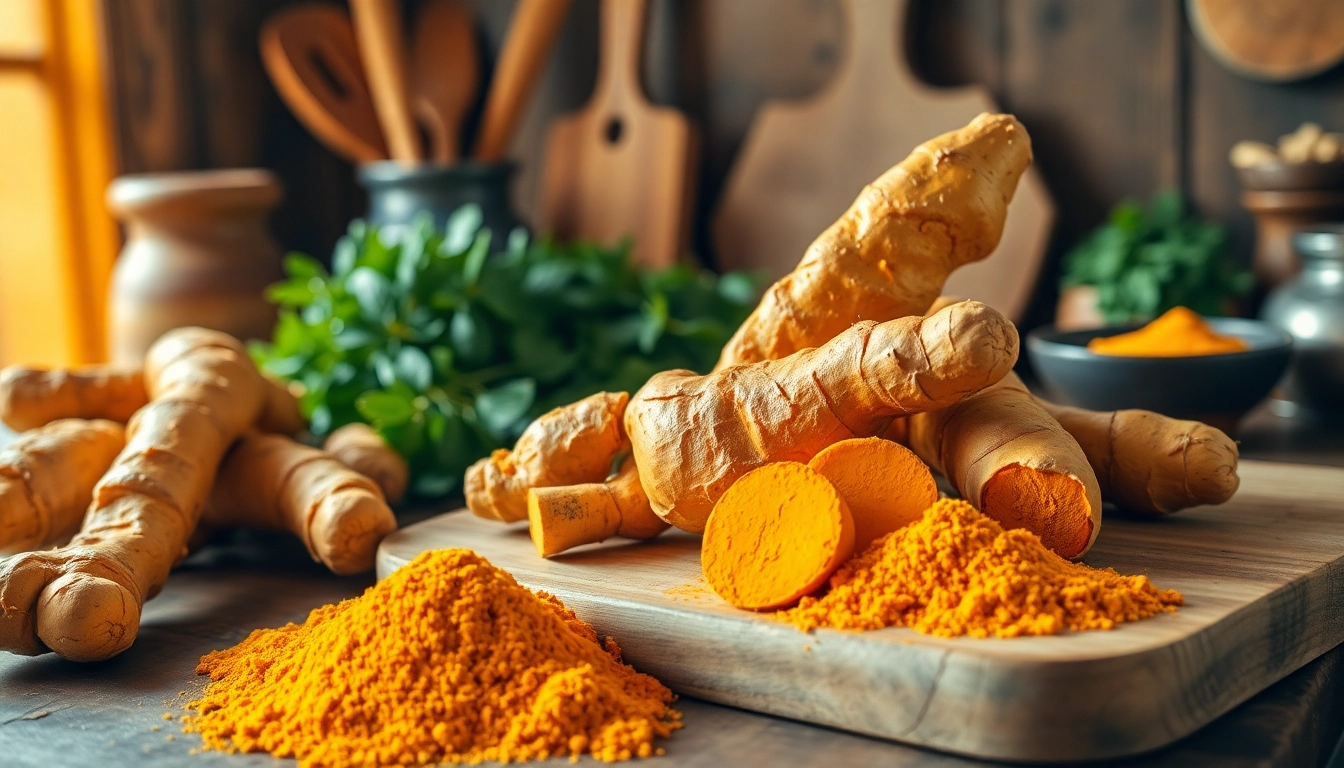Understanding Turmeric Root: Origin and Characteristics
Turmeric root, derived from the rhizome of the Curcuma longa plant, is a golden spice native to South Asia. As a close relative of ginger, turmeric has been an integral part of various culinary and medicinal practices for centuries. Originally cultivated in India and other parts of Asia, turmeric has undergone a commendable journey across continents, where it’s now celebrated for its multifaceted uses and health benefits. Today, you can find high-quality turmeric root in various forms, from whole roots to powders, each aligning with different purposes and preferences.
The Botanical Background of Turmeric
Botanically classified under the Zingiberaceae family, turmeric comprises numerous species, with Curcuma longa being the most prominently used variation. The turmeric plant generally reaches about three to four feet in height and thrives in tropical climates with ample rainfall. Turmeric is cultivated primarily for its rhizomes, which are harvested, dried, and often ground into powder for culinary or medicinal uses. The unique vibrant hue of turmeric, stemming from its curcumin content, is not just captivating; it signifies its rich nutritional profile.
Unique Properties of Turmeric Root
Turmeric root holds remarkable characteristics that contribute to its health benefits. One of the most significant compounds found in turmeric is curcumin, a polyphenol known for its anti-inflammatory and antioxidant properties. Beyond curcumin, turmeric is composed of vitamins, minerals, and essential oils, which together provide an impressive nutritional profile. The active compounds in turmeric can offer various health advantages, including improved digestion, enhanced immune response, and potential anticancer effects.
Cultural Significance in Various Cuisines
Incorporated into numerous dishes worldwide, turmeric is particularly celebrated in South Asian and Middle Eastern cuisines, often featured in curries, rice dishes, and marinades. However, its influence extends beyond culinary applications; in India, turmeric is symbolic of auspiciousness in rituals and celebrations. Its soothing properties have made it a cornerstone in traditional medicine practices, including Ayurvedic and Chinese medicinal systems. Turmeric not only adds flavor and color to meals but also brings a cultural richness that encapsulates age-old traditions.
Health Benefits of Turmeric Root
The numerous health benefits attributed to turmeric root stem from its bioactive compounds. Researchers have dedicated decades to studying its potential, unveiling results that bolster its reputation as a superfood. Below, we delve into some of the most well-documented health advantages of turmeric root.
Anti-inflammatory and Antioxidant Properties
Turmeric is renowned for its potent anti-inflammatory effects largely attributed to curcumin. Chronic inflammation is a precursor to several health issues, including heart disease, diabetes, and cancer. By incorporating turmeric into your diet, you may aid in reducing inflammatory markers, thereby maintaining overall health. Furthermore, as a strong antioxidant, turmeric helps combat oxidative stress and free radicals in the body. This dual action of anti-inflammation and antioxidation showcases turmeric’s potential in enhancing longevity and promoting good health.
Potential Role in Disease Prevention
Research has pointed to turmeric’s potential protective effects against various diseases. For example, studies suggest that curcumin may reduce the risk of heart disease by improving endothelial functions, a critical factor in maintaining cardiovascular health. Additionally, turmeric may showcase anticancer properties, with some findings indicating that curcumin can hinder the growth of cancer cells and tumor formation. Other benefits include potential advantages in managing diabetes, arthritis, and neurodegenerative diseases such as Alzheimer’s. The evidence continues to grow, demonstrating the multifactorial benefits of incorporating turmeric into your daily regimen.
How Turmeric Affects Overall Wellness
A consistent intake of turmeric may bolster overall wellness and improve quality of life. The anti-inflammatory and antioxidant properties help strengthen the immune system, optimize digestive health, and enhance mood stability. Some studies have indicated that curcumin may contribute to improved mental health outcomes, potentially serving as a complementary approach to managing symptoms of depression and anxiety. By fostering holistic health, turmeric facilitates a synergistic balance within the body, promoting well-being from the inside out.
Incorporating Turmeric Root Into Your Diet
Integrating turmeric root into your meals can be an enjoyable culinary adventure. Whether you choose fresh turmeric or powdered forms, the possibilities are endless. Below are some practical ways to harness the health-packed benefits of turmeric in your daily cooking.
Delicious Recipes Featuring Turmeric Root
Turmeric root can elevate a variety of dishes with its bold flavor and vibrant color. Some popular recipes include:
- Golden Milk: A warm beverage comprising turmeric, ginger, cinnamon, and milk (or a dairy-free alternative). This soothing drink is not only delicious but may also aid in relaxation.
- Turmeric Rice: Season your rice with sautéed onions, garlic, turmeric, and broth for a flavorful twist.
- Curried Vegetables: A medley of seasonal vegetables sautéed with turmeric, garlic, and spices, offering not just flavor but a nutritional punch as well.
- Smoothie Boost: Add fresh or powdered turmeric to your smoothies for a nutrient-packed drink that promotes health.
Using Turmeric in Teas and Smoothies
Incorporating turmeric into drinks is a fantastic way to consume it effortlessly. Try brewing turmeric tea by simmering fresh turmeric with ginger and lemon. You can also create a refreshing turmeric smoothie by blending banana, spinach, turmeric, and coconut milk. The versatility of turmeric means you can add it to most beverages without compromising flavor, while still doling out its benefits.
Popular Cooking Techniques with Fresh Turmeric
Fresh turmeric root can be treated with various cooking techniques, amplifying its flavor and efficacy:
- Grating: Fresh turmeric root can be grated and added to salads or dressings, enhancing raw dishes with its aromatic spice.
- Sautéing: Sauté grated turmeric with vegetables or proteins to release its essential oils, enriching your meal with health benefits.
- Infusing: Infuse oils or dressings with turmeric by allowing fresh grated turmeric to steep in olive oil or vinegar.
Understanding Turmeric Root Supplements
The rise in turmeric’s popularity has led to an influx of turmeric root supplements, catering to those seeking concentrated doses of curcumin’s benefits. Understanding the different forms of supplements and their appropriate usage is crucial for maximizing their potential.
Different Forms of Turmeric Supplements
Turmeric supplements vary in form, including capsules, powders, tinctures, and extracts. Capsules often contain concentrated curcumin, making them a convenient option for those who prefer supplementation over culinary use. Powders are versatile, as they can be added to a variety of dishes or mixed with drinks. Tinctures are liquid extracts that can be taken under the tongue for quicker absorption. When choosing supplements, it’s important to look for products with black pepper extract (piperine) as it enhances curcumin absorption significantly.
Dosage Guidelines and Safety Considerations
While turmeric is generally safe, moderation is key. Typical dosages of curcumin in supplements range from 500 to 2000 mg daily, but consulting with a healthcare professional is advisable, especially for pregnant women, breastfeeding mothers, or individuals on certain medications. The side effects from excessive consumption may include gastrointestinal disturbances, so adhering to recommended dosages is crucial.
Choosing Quality Turmeric Products
When selecting turmeric products, it’s vital to choose high-quality sources to ensure maximum benefits. Look for organic certifications, third-party testing for quality assurance, and bioavailability-enhanced formulations. Reputable brands often provide transparency regarding their sourcing and manufacturing processes and detailed information about the curcumin concentration present in their products.
Common Myths and Misconceptions About Turmeric Root
Despite its widespread use and numerous studies backing its health claims, misconceptions about turmeric persist. It’s important to distinguish fact from fiction to utilize turmeric effectively.
Debunking Health Claims
While turmeric is often hailed as a cure-all, it is essential to approach health claims scientifically. For instance, while turmeric possesses anti-inflammatory properties, it should not be seen as a substitute for prescribed medications for chronic conditions. Instead, it should complement an overall healthy lifestyle and treatment plan, moderated by professional advice.
Understanding Potential Side Effects
While turmeric is generally regarded as safe, some individuals may experience side effects such as nausea, digestive discomfort, or allergic reactions. Additionally, turmeric might interact with medications that affect blood clotting, leading to increased bleeding risk. Anyone considering turmeric for medicinal purposes should consult with healthcare professionals to ensure safe practices and avoid adverse outcomes.
Distinguishing Myth from Fact
A common belief is that turmeric alone can treat serious conditions like cancer or heart disease. While turmeric can contribute positively to prevention and management strategies, finding a balance with other lifestyle and dietary factors is paramount. Its potency is enhanced when used as part of a well-rounded health regimen rather than as a standalone treatment.



